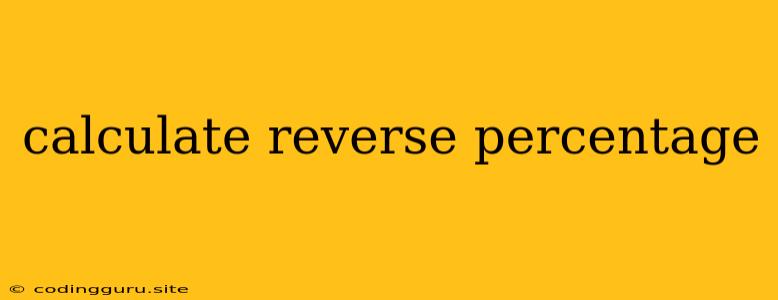Calculating Reverse Percentage: A Comprehensive Guide
Have you ever encountered a scenario where you're presented with a final value and need to determine the original value before a percentage increase or decrease was applied? This is where the concept of reverse percentage comes into play. It's a valuable skill to have in various situations, from understanding sales discounts to analyzing financial data.
Let's delve into the intricacies of reverse percentage calculation and equip you with the knowledge to tackle such problems confidently.
Understanding Reverse Percentage
In essence, reverse percentage is the process of finding the original value before a percentage change was applied to it. It's like reversing the clock, going back in time to uncover the starting point.
Imagine you bought a product on sale, and the discounted price is $100. You know the discount was 20%. Now, you want to figure out the original price before the discount. This is where reverse percentage comes into play.
The Formula and Steps
The core formula for calculating reverse percentage involves a simple yet powerful equation:
Original Value = Final Value / (1 + (Percentage Change / 100))
Let's break down the steps to apply this formula:
- Identify the Final Value: This is the value you have after the percentage change has been applied.
- Determine the Percentage Change: This is the percentage by which the original value was increased or decreased.
- Convert Percentage Change to Decimal: Divide the percentage change by 100 to convert it into a decimal form.
- Apply the Formula: Plug the final value and the decimal form of the percentage change into the formula.
- Calculate the Original Value: Solve the equation to obtain the original value.
Example: Finding the Original Price
Let's revisit the example of the discounted product. The final price is $100, and the discount is 20%.
- Final Value: $100
- Percentage Change: -20% (since it's a discount, it's negative)
- Decimal Form of Percentage Change: -20/100 = -0.2
- Formula: Original Value = $100 / (1 + (-0.2))
- Calculation: Original Value = $100 / (0.8) = $125
Therefore, the original price of the product was $125 before the 20% discount.
Reverse Percentage for Increases
The same formula applies when dealing with percentage increases.
Let's say you invested $500, and your investment grew by 15%. You want to find the original investment before the growth.
- Final Value: $500 + (15/100) * $500 = $575
- Percentage Change: 15%
- Decimal Form of Percentage Change: 15/100 = 0.15
- Formula: Original Value = $575 / (1 + 0.15)
- Calculation: Original Value = $575 / 1.15 = $500
Therefore, your original investment was indeed $500.
Real-World Applications of Reverse Percentage
Reverse percentage has numerous practical applications in various fields:
- Finance: Analyzing stock prices, calculating returns on investments, and understanding the impact of inflation.
- Sales and Marketing: Determining the original price of discounted items, evaluating sales performance, and assessing the effectiveness of promotional campaigns.
- Data Analysis: Examining trends and patterns in data, identifying outliers, and uncovering underlying relationships.
- Everyday Life: Calculating tips, figuring out the cost of items before taxes, and understanding price increases.
Tips for Success with Reverse Percentage
- Keep Track of the Percentage Change: Remember that percentage increases are positive, while discounts or decreases are negative.
- Use a Calculator: For complex calculations, a calculator will make the process more efficient.
- Double-Check Your Work: Verify your calculations to ensure accuracy, especially when dealing with financial matters.
- Practice Makes Perfect: The more you apply the reverse percentage formula, the more comfortable you'll become with it.
Conclusion
Understanding reverse percentage is a valuable tool for making informed decisions in various situations. It empowers you to analyze data, uncover hidden information, and make better financial choices. By mastering the formula and practicing its applications, you'll gain a deeper understanding of percentage changes and their impact on real-world scenarios.
